Google Unveils New Look; Facebook Ad Targeting Weakens
— May 22, 2019
Although it certainly felt like Google Marketing Live 2019 took over the online advertising world for a minute there, we’ve still got some important news to talk about. Here’s the latest from Facebook, Instagram, and—believe it or not—Google.
Google unveils new look for mobile search results
In order to free up space for more information and on-SERP action buttons, Google has unveiled their reimagination of the mobile search results. Take a look at the image Senior Interactions Designer Jamie Leach included in Wednesday’s announcement:
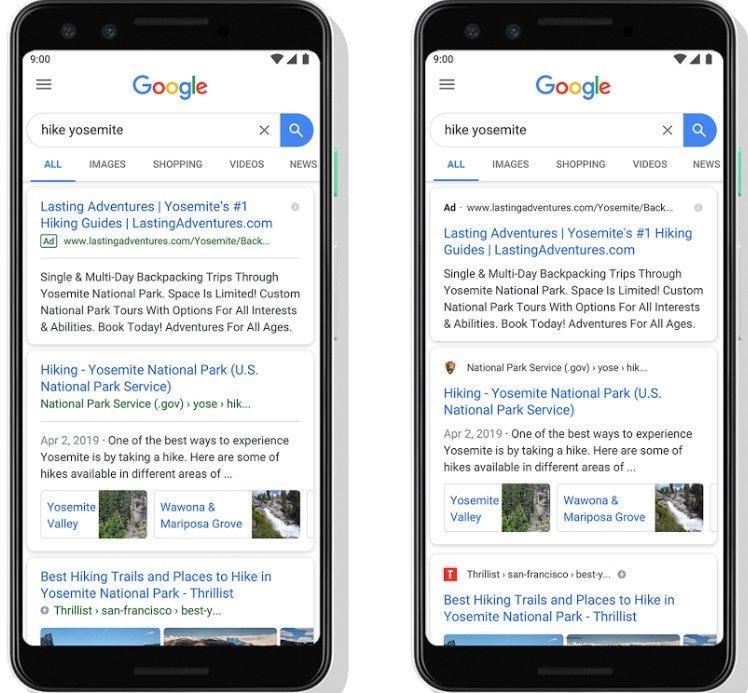
The new look is on the right. Via Google.
As you can see, the “Ad” indicator and the display URL—which often serves as crucial brand real estate—will move above the ad headline. Publisher names and icons will move above the headline in the organic results as well. Although the display URL we’ve come to know and love has certainly done a good job of presenting your brand name, the new look—rolling out in the coming days—makes sure to position it even more prominently.
Leach explains the motivation behind this reimagination at the end of his blog post:
“As we continue to make new content formats and useful actions available—from buying movie tickets to playing podcasts—this new design allows us to add more action buttons and helpful previews to search results cards.”
Translation: Google wants to give users the most seamless search experience possible. Whether you’re simply searching for information or deliberately looking to make a purchase, Google wants to erase as much pain from the process as possible—especially when you’re on mobile (see: the new gallery ad format coming to the SERP later this year).
Now, I know what’s coming to mind for many of you: traffic. After all, the more information Google scrapes from your site, the less necessary it is for users to click through. Although that’s valid cause for concern, I’ll say this: Google reducing friction does not equate to Google eliminating the need to visit your website. As you can see in this screenshot, one type of button Google is aiming to make room for is essentially the organic version of a sitelink extension:
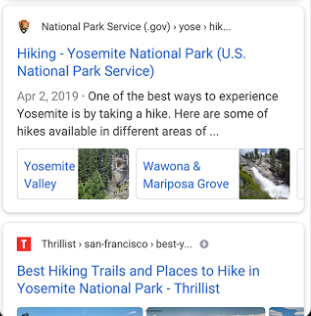
Friction-reducing? Quite. Traffic-leeching? Hardly.
Shifting back to the paid side of things, the addition of new action buttons should do wonders for low-funnel search initiatives. Whether you’re trying to book appointments or drive sales, the erasure of steps required to secure a conversion is (almost) always a good thing.
Facebook’s transparency measures may affect targeting
In a recent blog post, Facebook announced the imminent roll out of a new tool that will enable users to see how advertisers are tracking them and—if they so choose—to take this ability away. As soon as a user disconnects their account from their online activity, Facebook will no longer be able to use this data when serving your ads.
For example, let’s say you’ve built a custom audience based on the people who’ve visited your product page within the past 30 days. Up until this point, you’ve been able to remarket to those site visitors with an offer for a free trial. Once Facebook rolls out this new tool to users, your prospects will have the opportunity to effectively remove themselves from that audience.
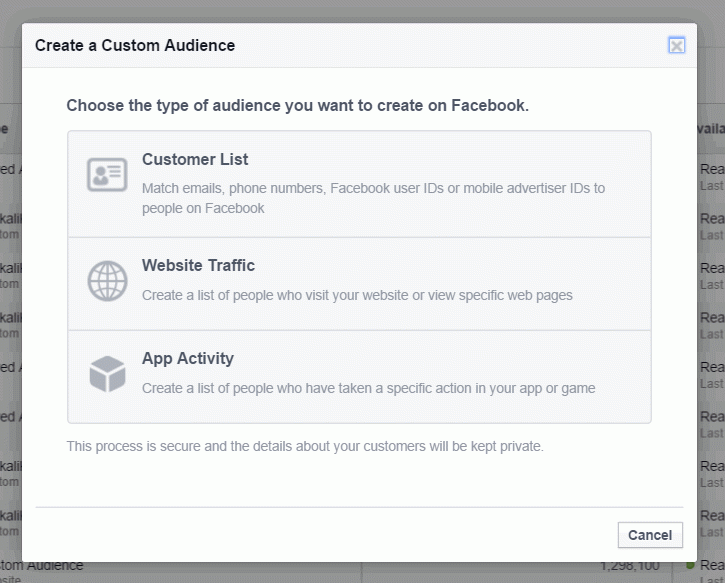
I think there are two things to keep in mind: (1) a lot of Facebook users won’t take advantage of this tool and (2) this is a good thing. As marketers, we should welcome improved privacy measures with open arms. The more secure people feel about the ways their personal data is being used, the more favorably they feel towards advertisements. As I mentioned in our recent round-up of Hero Conf 2019, Quora’s JD Prater shared the rather unsettling news that the general public perceives Congress more favorably than it does advertisers.
Evidently, we could use a bit of a boost in the court of public opinion. If this new tool works as it’s supposed to, all of us—consumers and marketers alike—will be better off for it.
Google discusses top 3 SEO ranking signals
Google Webmasters officially kicked off their new SEO Mythbusting series by publishing the inaugural episode on YouTube. After discussing the basics of search engines and crawling, the guest developer, Juan Herrera, asked Google’s Webmaster Trends Analyst, Martin Splitt, to name the top three things he should focus on to improve his organic search visibility.

Because that’s a fairly broad and challenging question, Splitt took a few minutes to articulate his answer. Here’s what he said in a nutshell:
- Create relevant, useful content. No surprises here, really. Google has long said that publishing high-quality, helpful content is paramount to all other ranking signals. If you’re thoughtful about the keywords you target and the user intent behind those keywords, you’re in good shape.
- Optimize your meta data. The meta data for a given page on your website includes things like the page title and the page description. When a user is looking at an organic search result, they’re seeing the publisher’s meta data. The blue hyperlinked text is the title; the text beneath that (often with parts of the search query in bold) is the description. Optimizing your meta data is a crucial part of letting both Google and users know what they can expect to find on your page.
- Improve your site performance. Although “site performance” is pretty vague, we can infer that Splitt was referring to attributes like speed, security, and navigability. Beyond publishing relevant content that matches user intent, maintaining a fast, secure, and intuitive website is essential to your organic search visibility. After all, if you’re not delivering a quality experience to visitors, why would Google rank your site?
None of these signals are new or groundbreaking. However, it’s not often that we hear a Google employee clearly outline the factors that matter most to organic search performance. Make sure to check out the episode for yourself, and stay tuned for more great content!
Instagram redesigns the Explore tab
In order to incentivize users to adopt the properties it considers most valuable—IGTV, Shopping, and Stories—Instagram has redesigned the Explore tab. The section of the app that users turn to when they want to discover new content from people, brands, and content creators they don’t yet follow, Explore is used by the majority of Instagram accounts every month.
First things first—we’ve got a new top navigation bar. Links to IGTV and Shopping are pinned to the front and followed by interest-based categories like food, art, and travel.
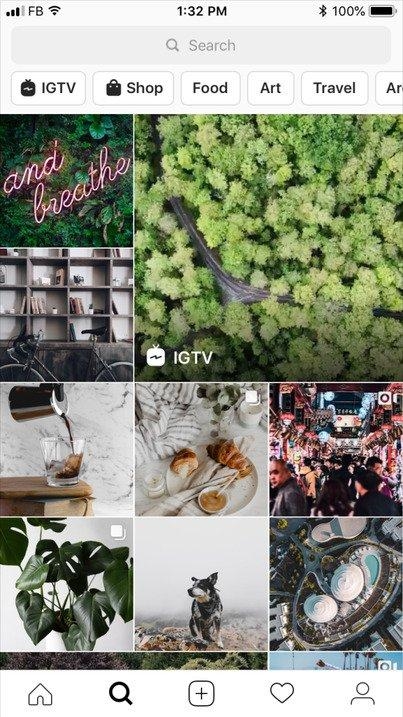
Via Instagram.
Like I said—this redesign is Instagram’s not-so-subtle attempt to increase adoption of the features it desperately wants users to adopt. IGTV, like Watch on big brother Facebook, aims to keep people on the platform for longer periods of time—and away, of course, from video behemoth YouTube. Elsewhere, Shopping (otherwise known as Checkout on Instagram) is at the core of Instagram’s effort to make it as much an ecommerce platform as it is a social platform.
Additionally, the redesigned Explore grid will feature Stories content as well as News Feed content. As we’ve discussed repeatedly on the blog over the past few months, users’ news feeds—on both Instagram and Facebook—are saturated with ads. Because this saturation places a constraint on monetization, the continued profitability of the platforms depends on their ability to move users and advertisers en masse to other properties—including Stories.
If nothing else, the reimagination of the Explore tab gives us insight into Instagram’s priorities going forward. If you’ve got the resources, establishing a presence on IGTV, Shopping (currently unavailable to most advertisers), and/or Stories is a smart move.
Facebook stresses importance of valuable News Feed content
Just because the News Feed isn’t the way of the future doesn’t mean Facebook is forgetting about it altogether. Recently, the company has been surveying users to determine what makes for a good News Feed experience—in terms of both interpersonal content and branded content. Regarding the latter, the key takeaway seems to be the importance of value. In other words, the performance of your content in the News Feed depends on your ability to deliver valuable, relevant experiences. If that sounds familiar, that’s because it’s identical to the philosophy behind organic search performance.
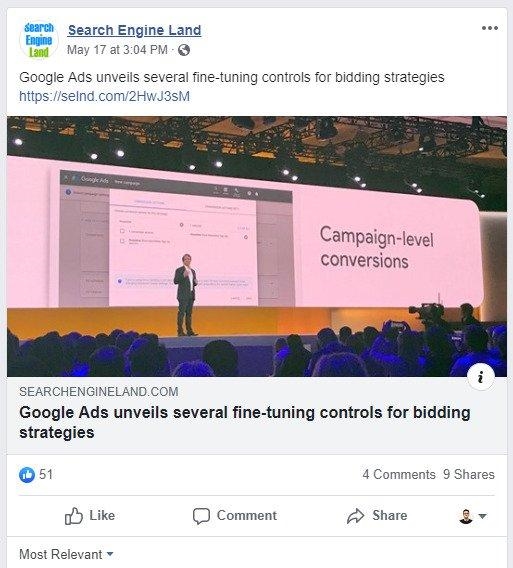
As obvious as that may seem, it’s important to take note of Facebook’s increased efforts to eliminate (or at least disincentivize) spammy, self-serving content. In the past, you could get away with sharing content focused solely on driving site traffic or garnering user engagement. In fact, we still see this in practice when publishers encourage users to tag their friends in the comments section. Recently, Facebook has made it clear that blatant attempts to hack the News Feed algorithm will have an adverse effect on performance.
What does this mean for you? It means you need to be thoughtful about the News Feed content you’re sharing. Nail down what your audience truly needs or wants to consume and let that guide you going forward. Say you’re using Facebook to promote private piano lessons, for example. Rather than trying to reach as many people as possible with comment spam, create educational content (blog posts, tutorial videos, etc.) that teaches your followers new things about the piano. In the long run, doing so will prove far more effective and rewarding.
Digital & Social Articles on Business 2 Community
(35)

